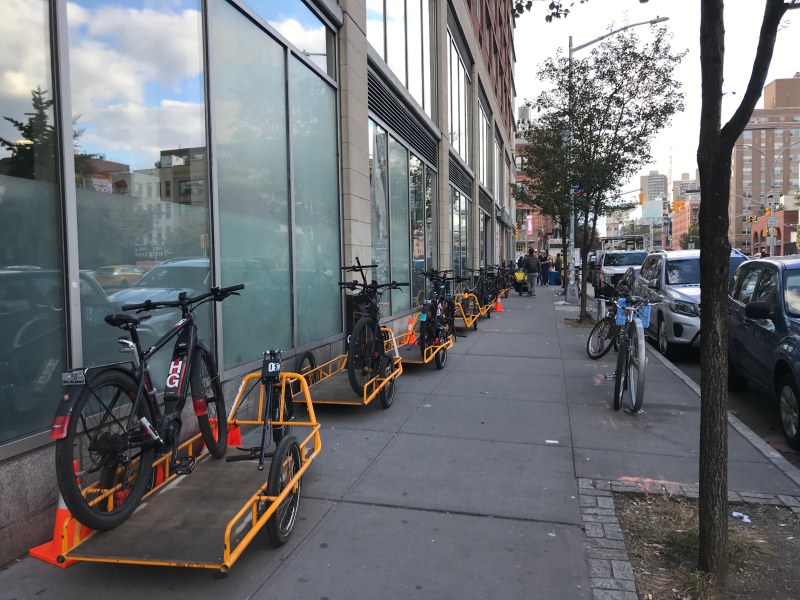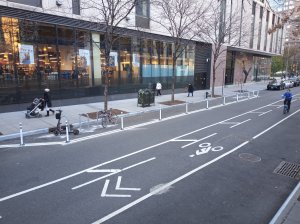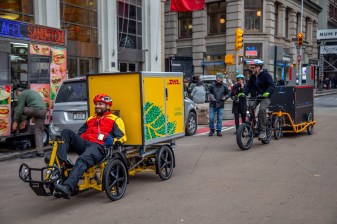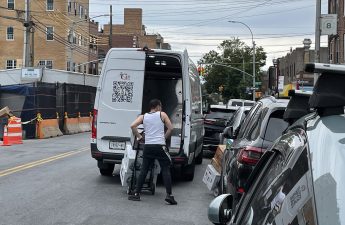Manhattan Panel Kills Proposed Cargo Bike Corral … To Save Five Parking Spots
"A loss of parking spaces in Lower Manhattan is a travesty," says one community board member.

A Manhattan community board — which has complained about double-parked trucks — killed a city proposal on Wednesday night that would have remedied that problem by creating a cargo bike loading dock. Board members instead said they wanted to preserve parking in a neighborhood where virtually no one owns a car.
A Department of Transportation proposal for Warren Street between West and Greenwich streets in TriBeCa would have converted five parking spots on the narrow road into a combination bike corral and loading zone for cargo bikes. But the CB1 executive committee rejected it, 6-4, sending the DOT back to the drawing board for a street change so minor that it is unclear why the agency even sought board approval.
The DOT had come to the community board with the idea so that the Whole Foods market on Warren would adopt the cargo bike delivery option that four other stores around the city currently use. The cargo bike corral, which would have been the first of its kind in New York City, would comprise a curbside space on Warren surrounded by vertical delineators to keep cars and trucks out of the spot, and would allow Whole Foods delivery riders a safe, off-road spot to load groceries for delivery. The new layout would also add public bike parking in the form of six bike rack sleds with three parking spots on each rack.
The loading zone would also keep Whole Foods cargo bikes off the sidewalk, where they’ve been forced to load deliveries in other locations using the pedal-powered grocery delivery method. Whole Foods is the only company participating in any real scale in the city’s cargo bike pilot announced late last year. Residents who live near other Whole Foods locations have complained that delivery works sometimes block sidewalks with their cargo bikes, which is why some have called for the city to create loading zone space for the bikes, just as it would for trucks.

Nonetheless, the DOT presentation went off the rails almost immediately, as committee member Mariama James said that in her opinion, “a loss of parking spaces in lower Manhattan is a travesty,” setting the tone for a reactionary hour of complaining about double-parked delivery vans in an effort to stop a proposal that would, er, cut down on the use of delivery vans and, therefore the double-parking.
“Since the Zero Vision program, or whatever it’s called, you realize that there have been more accidents then before,” said committee member Bruce Ehrmann, who also complained that DOT has too much “input on city streets” (which is actually the agency’s primary mission).
Another committee member scoffed at the idea of the bike sleds, which would be publicly available bike parking, were not a community benefit because “you can park your bike any place.” [This is factually inaccurate; other Manhattan community boards have begged for additional bike parking, and for years the city has struggled to keep up with its own bike parking installation goals. Cyclists consistently say the lack of bike parking is an impediment to greater participation in this pollution-free transportation mode.]
Getting the cargo bike pilot rolling is especially important in light of the newest greenhouse gas emissions numbers that the city released this week, which showed that emissions from both heavy-duty and medium-duty trucks rose 5 percent between 2005 and 2019. Cargo bikes are mostly used by Whole Foods, which has put about 100 of the game-changing transport units on the street since last year.
“If you want to have a cargo bike program, you have to have stuff like this, and they shouldn’t be decided at random by community boards,” said Bike New York Communications Director Jon Orcutt.
Board members also suggested throwing pedestrians under the bus by having the Whole Foods use a wide sidewalk around the corner from Warren Street as its cargo bike loading zone.
“Is there any reason why that big sidewalk on Greenwich Street is not being utilized?” one board member asked, happy to take pedestrian space away in order to save a handful of parking spots in a neighborhood overflowing with public transportation options and where 76.5 percent of households don’t own a car according to the census.
The suggestion to explore giving Whole Foods a piece of the sidewalk instead of the street was included in a list of ideas for the city to look at before it returns to CB1 with a revised proposal.
The DOT did not respond to a request for comment on what it will do with the proposal given the rejection by the board, whose opinion is only advisory anyway.
Orcutt warned that the de Blasio administration is running out of time to leave a positive impact on the streetscape and that the mayor has to decide whether he wants to get things done or just propose things to be killed off by pro-car interests.
“It’s not way to run the greatest city in the world,” Orcutt said about the current setup.
It’s just the latest example of city initiatives completely stymied by a small cohort of community board members who do not want to see parking eliminated, even in neighborhoods with very little car ownership. Earlier in the week, the district manager of Community Board 1 in Queens demanded that DOT place more Citi Bike racks on sidewalks instead of streets because car owners would have a more difficult time finding parking.
The city tweaked a residential loading zone program last year after several neighborhoods complained about lost parking spaces, even though loading zones tend to help traffic flow better because of less double-parking.
And last year, Bay Ridge residents were told that they were getting less safe roadways because DOT declined to remove parking from some key bike routes. And the city has ruined its own dedicated bus lanes to appease car owners on many occasions.
The city has also, on occasion, ignored the demands of entitled car owners, as it did by removing hundreds of curbside spaces to build the life-saving Central Park West protected bike lane last year.


